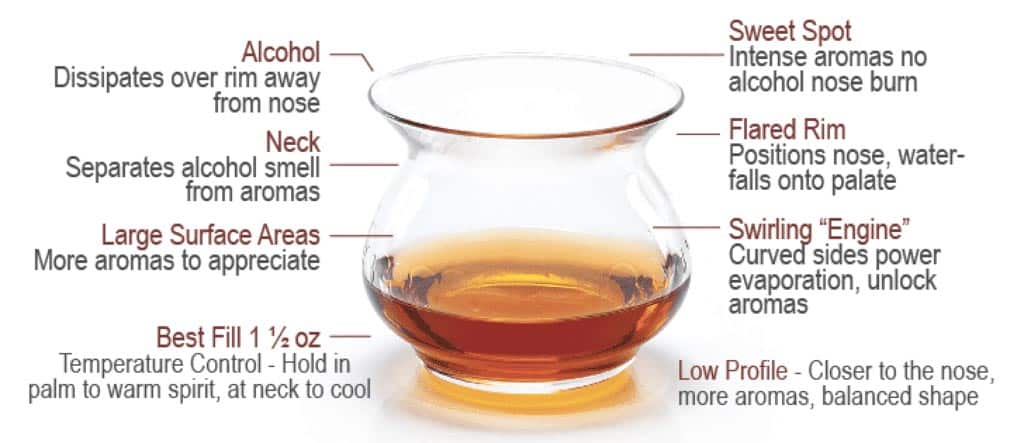
Designing a functional spirit glass
For decades the tulip glass, also called copita has been used as a spirits nosing and tasting glass. Originally borrowed from Spanish sherry, it earned the name “dock glass,” as it was used at the wharf to seal the deal as buyers tasted goods to verify quality before payment. Adopted and promoted as the identifying icon of the whisky industry, unfortunately, its design is all wrong when it comes to nosing and tasting science. The high ethanol in spirits renders the tulip glass non-functional for detecting aromas due to high alcohol concentration. Three sniffs and it’s all over. In addition, tulip glasses are not friendly to women’s more sensitive olfactory. Using a tulip glass designed for 20% ABV sherry for 40%+ ABV spirits creates a nose bomb that destroys your sense of smell.
TWO CENTURIES OF TULIP GLASSWARE DESIGNED FOR 20% ABV SPANISH SHERRY
Keeping the same design parameters to maintain iconic identity with the scotch whisky industry does not come without consequence. 40% abv spirits have too much alcohol for such a small glass, burning the nose and numbing the sense of smell. Tulip glasses concentrate alcohol, mask character aromas, and are too tall for the nose to detect complex aromas and quality.
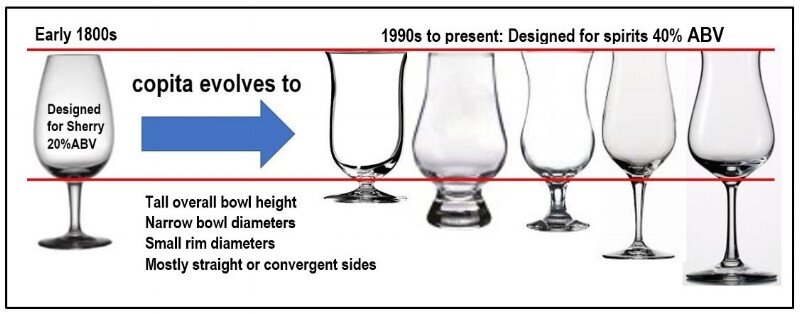
TULIP GLASS CONCENTRATES AND FORCES ALCOHOL AROMA INTO THE NOSTRILS
Not really news, since American cocktail glass designers in the 30’s knew USA booze quality was horrible, and divergent rims would dissipate aromas of poorly made spirits. The alcohol cloud formed by tulip shapes increases difficulty of detecting specific aromas. What’s so bad about alcohol? Simple. Its an anesthetic which numbs more human olfactory sensors with every sniff. Many drinkers mistakenly believe more alcohol means higher quality. Could that be why cask strength spirits are popular?
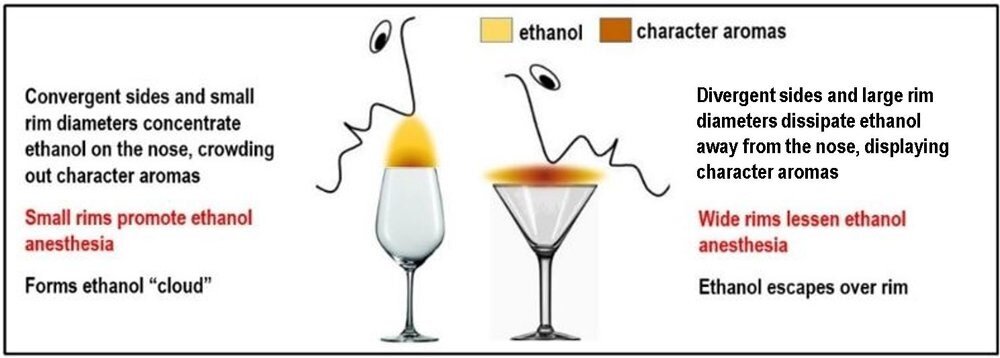
CREATE A NEW GLASS FROM THE BEST OF BOTH SHAPES
The divergent glass dissipates aromas, and large convergent glass promotes swirling and evaporation yet concentrates aromas. Placing the divergent flared rim above the convergent rim creates a “neck” in the design, which is key to separating ethanol from character aromas. (Graham’s Law of Diffusion for the curious). The neck begins the separation process and controlled divergence dissipates volatile alcohol to the outer rim away from the nose enhancing detectability of character aromas. Character aromas tell you what you are drinking; bourbon, scotch whisky, rum, gin, or even vodka, as well as define true spirit quality.
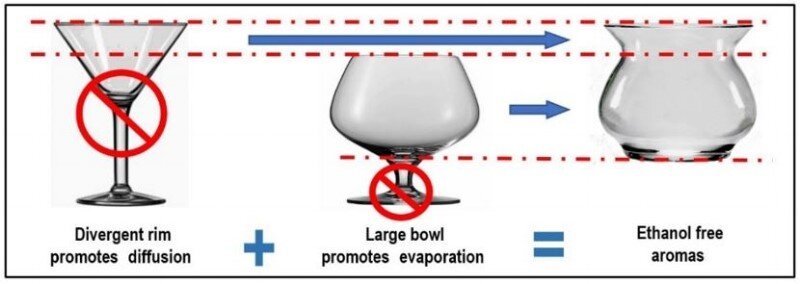
TALL GLASSES MISS MANY CHARACTER AROMAS
Each different aroma has a different molecular mass. That means that gravity, as well as molecular shape affects larger mass aromas differently than smaller mass, simple shape aromas like alcohol. The closer your nose is to the liquid surface, the more aromas you smell. This is important for detecting all the spirit’s subtle aromas. The neck of the NEAT spirits glass is less than half the distance to the rim of a tulip glass, providing more complex character aromas to display above the neck for evaluation.
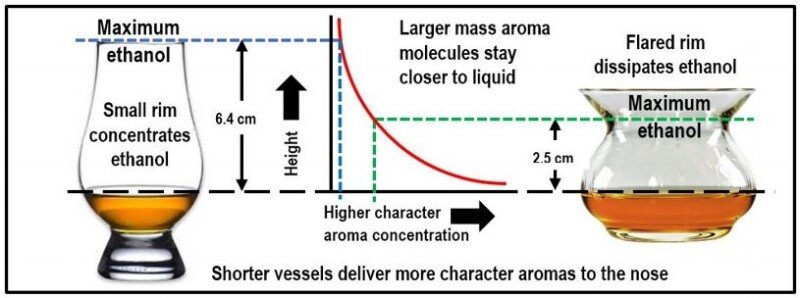
ALL AROMAS ARE DISPLAY FOR BETTER DETECTION WITHOUT ALCOHOL SMELL
Real science displays all aromas in the NEAT spirits glass, allowing quick and easy detection of the subtleties the distiller intended. No more hunting for aromas that become difficult to identify through alcohol. Diagram shows where in the rim plane you can detect specific aromas in a typical whisk(e)y. Some make misleading statements regarding fluid dynamics, which has nothing to do with aroma detection, “inventing” their own brand of science. We marvel at the use of blatantly misleading, false information on “tongue maps” and unintelligible references to bio mimicry to sell glasses by twisting science to imply function.
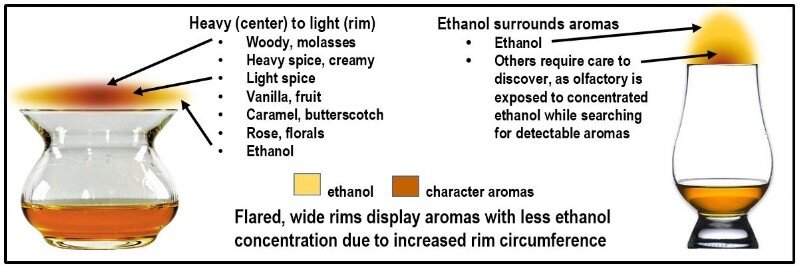
TULIP GLASS AROMAS ARE A GUESSING GAME – NO GUESSING WITH NEAT
The NEAT spirits glass was designed to stop “aroma hunting” and excessive sniffing that comes with all tulip glass shapes. More sniffing in the tulip glass causes quick alcohol nose numbing. With the NEAT spirits glass, its easy. Start in the center of the rim plane where there is no nose-numbing alcohol. NEAT spirits glass displays all character aromas from center to rim edge.


THE NEAT SPIRITS GLASS IS THE ULTIMATE SPIRITS GLASS
NEAT spirits glass does everything better than tulip glasses. Science built a better glass, changing the way the world drinks. Most major spirits judging competitions choose NEAT as their official spirits judging glass. No more nose-numbing or pungent burn in the nostrils. Sensitive noses and professionals love NEAT. If you are an incurable sniff-aholic, and love strong alcohol, stick your nose further into the glass to get the blast of pain and nose numbing you crave. Unfortunately it will destroy your sense of smell. Wouldn’t you rather use a spirits glass that gives you options, displays aromas, shows true quality and protects your sniffer?
The worst side effect of tulip glasses is their gender exclusivity. Concentrating ethanol is disagreeable to the more sensitive female nose and can even be painful. Ever wonder why there are so few women in whiskey clubs and attending spirits events? Peer pressure and a “good-ole-boys” fraternal atmosphere inadvertently excludes ladies who don’t want to drink from tulip glasses. Its time to get smart and bring sensitive noses into the appreciation of spirits, and the ladies have a lot to offer through better sensory awareness.
MDPI Beverage Journal published a significant research report on November 22, 2018 regarding scientific research which led to design and development of the NEAT glass. Peer-reviewed by olfactory science researchers, this report validates the superiority and suitability of the NEAT glass for evaluation and drinking enjoyment, and highlights major problems associated with beverage industry support for tulip and snifter-style glassware. Myth, tradition, and misleading marketing eventually give way to science, truth, and function.
Check it out, Sensation Research performed an independent study of NEAT vs Glencairn vs Snifter.

